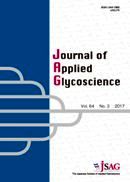
- Issue 4 Pages 113-
- Issue 3 Pages 83-
- Issue 2 Pages 51-
- Issue 1 Pages 1-
- |<
- <
- 1
- >
- >|
-
Small-scale Rice-gel Preparation from GrainsJunko Matsuki, Tomoko Sasaki, Koichi Yoza, Junichi Sugiyama, Hideo Mae ...2019Volume 66Issue 4 Pages 113-119
Published: November 20, 2019
Released on J-STAGE: November 20, 2019
Advance online publication: October 24, 2019JOURNAL OPEN ACCESS FULL-TEXT HTMLRice-gel prepared by the following three steps: rice grain cooking, shearing of the cooked rice, and cooling for gel formation, is expected as a novel food ingredient for modification of various food products such as bread and noodles. To meet the demand for high-throughput systems for research and developments on the new rice gels, herein we established a mini-cooking system for preparation of rice gel samples from grains using a small-scale viscosity analyzer (Rapid Visco Analyzer; RVA). Polished rice grains (4 g) were cooked with 22 mL of water in a canister, and the paddle equipped in the canister was rotated at 2,000 rpm for 30 min (80 °C was used as a representative) to shear the cooked rice. The sheared paste was cooled to 10 °C at 160 rpm, and the initial gelation property was evaluated by viscosity analysis within the RVA. Alternatively, the sheared paste was transferred to an acrylic mold and kept at 4 °C for 0, 1, 3, and 5 days for determination of the hardness with a compression test. Compressive forces required to penetrate 20 % thickness for three tested rice cultivars were measured, and the trend of the value shifts during preservation is similar to the corresponding trend obtained in 300-g grain scale laboratory tests, whereas the individual values were halved in the former. This small cooking method could offer a useful assay system for a rapid evaluation in the breeding programs and in the high-throughput screening of additives for the modification of properties.
View full abstractDownload PDF (363K) Full view HTML -
Continuous Production of Lactulose Syrup Using an Organogermanium CompoundTakae Nagasawa, Katsuyuki Sato, Takafumi Kasumi2019Volume 66Issue 4 Pages 121-129
Published: November 20, 2019
Released on J-STAGE: November 20, 2019
Advance online publication: October 24, 2019JOURNAL OPEN ACCESS FULL-TEXT HTMLLactulose, a keto-type disaccharide widely used in pharmaceuticals and functional foods, is produced by the isomerization of lactose. The organogermanium compound poly-trans-[(2-carboxyethyl) germasesquioxane] (Ge-132) is an effective reaction promoter for the conversion of lactose to lactulose because of its high affinity to ketoses. Herein, an effective method for the continuous production of lactulose syrup was developed using Ge-132 through the alkaline isomerization of lactose in a bench-scale plant. This plant carried out a continuous isomerization process using Ge-132, continuous two-step separation process for separating the sugar and Ge-132, a continuous purification and concentration processes for the lactulose syrup, and separation and purification processes for the recovery of Ge-132. In this bench-scale plant, lactulose-containing syrup (350 g/L lactulose, 92 g/L lactose, and 31 g/L galactose) was prepared. The syrup was produced at a rate of 37.7 mL/h, and the content of residual Ge-132 in the syrup was 2 mg/L. The separation process was a two-step separation system requiring an ordinary electrodialyzer and an electro deionizer, which allowed the separation of more than 99.6 % Ge-132 from the reaction mixture. Moreover, the majority of Ge-132 and sodium hydroxide were recovered through electrodialysis using a bipolar membrane. The proposed system is the first to represent the novel development of an effective continuous production system for lactulose-containing syrup on the basis of the use of organogermanium compounds and incorporation of the electrodialysis technology.
View full abstractDownload PDF (516K) Full view HTML -
Acetylxylan Esterase from Irpex lacteusSangho Koh, Seika Imamura, Naoto Fujino, Masahiro Mizuno, Nobuaki Sato ...2019Volume 66Issue 4 Pages 131-137
Published: November 20, 2019
Released on J-STAGE: November 20, 2019
Advance online publication: October 24, 2019JOURNAL FREE ACCESS FULL-TEXT HTMLThe carbohydrate esterase family 1 (CE1) in CAZy contains acetylxylan esterases (AXEs) and feruloyl esterases (FAEs). Here we cloned a gene coding for an AXE belonging to CE1 from Irpex lacteus (IlAXE1). IlAXE1 was heterologously expressed in Pichia pastoris, and the recombinant enzyme was purified and characterized. IlAXE1 hydrolyzed p-nitrophenyl acetate, α-naphthyl acetate and 4-methylumbelliferyl acetate, however, it did not show any activity on ethyl ferulate and methyl p-coumarate. We also examined the activity on partially acetylated and feruloylated xylan extracted from corncob by hydrothermal reaction. Similarly, ferulic and p-coumaric acids were not liberated, and acetic acid was only detected in the reaction mixture. The results indicated that IlAXE1 is an acetylxylan esterase actually reacted to acetyl xylan. However, since IlAXE1 was unable to completely release acetic acid esterifying xylopyranosyl residues, it is assumed that acetyl groups exhibiting resistance to deacetylation by IlAXE1 are present in corn cob xylan.
View full abstractDownload PDF (373K) Full view HTML
-
D-Allose Extends Nematode Lifespan via Sirtuin and Insulin SignalingTomoya Shintani, Hirofumi Sakoguchi, Akihide Yoshihara, Ken Izumori, M ...2019Volume 66Issue 4 Pages 139-142
Published: November 20, 2019
Released on J-STAGE: November 20, 2019
Advance online publication: October 24, 2019JOURNAL OPEN ACCESS FULL-TEXT HTMLD-Allose (D-All), C-3 epimer of D-glucose, is a rare sugar known to suppress reactive oxygen species generation and prevent hypertension. We previously reported that D-allulose, a structural isomer of D-All, prolongs the lifespan of the nematode Caenorhabditis elegans. Thus, D-All was predicted to affect longevity. In this study, we provide the first empirical evidence that D-All extends the lifespan of C. elegans. Lifespan assays revealed that a lifespan extension was induced by 28 mM D-All. In particular, a lifespan extension of 23.8 % was achieved (p < 0.0001). We further revealed that the effects of D-All on lifespan were dependent on the insulin gene daf-16 and the longevity gene sir-2.1, indicating a distinct mechanism from those of other hexoses, such as D-allulose, with previously reported antiaging effects.
View full abstractDownload PDF (598K) Full view HTML
- |<
- <
- 1
- >
- >|